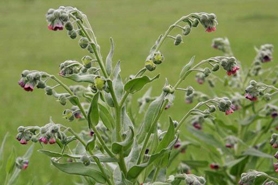Hounds tongue
(Cynoglossum officinale)
An herbaceous biennial that can grow 1-4' tall on a single stem that branches above.
Other names for this plant include:
- Common names: ordinary hound's tongue, gypsy flower, dog's tongue
- Scientific names: Cynoglossum officinale L.f. bicolor
Classification in Wisconsin: Restricted
Ecological Threat
- Invades pastures, roadsides, grasslands, riparian areas and meadows.
- Alkaloids in the plant decrease toxicity as it matures, yet they can still be toxic to horses and cattle.
Identification
Leaves: Elliptical, alternate leaves are dark green and slightly hairy. In the rosette stage, leaves are 6-8" long; in the second year, basal leaves are up to 12" long and reduce in size as they progress up the stem.
Flowers: Arranged in panicles in the upper leaf axils, red-purplish flowers bloom from June-July. They are up to 0.3" wide, have five petals and are saucer to funnel-shaped.
Fruits & seeds: Each flower produces four nutlets, or small nuts, covered in barbs. Nutlets that remain on the plant are viable for 2-3 years.
Roots: Large, woody taproot.
Control
Mechanical: Mow second-year plants while in the flowering stage before seed production. Use a sharp shovel to cut 1-2" below the soil surface.
Chemical: Foliar spray rosettes in spring using 2% solutions of picloram, dicamba, or metsulfuron.
Resources
Sources for content:
- The University of Washington - The Burke Museum of Natural History and Culture.
- Cynoglossum officinale. Klinkenberg, Brian. (Editor) 2009. E-Flora BC: Electronic Atlas of the Plants of British Columbia [eflora.bc.ca]. Lab for Advanced Spatial Analysis, Department of Geography, University of British Columbia, Vancouver.
Links for more information:



